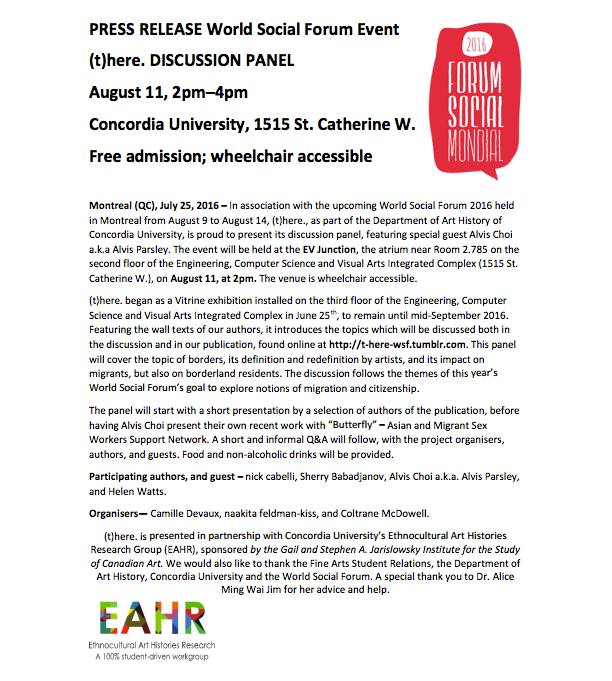 August 11, 2pm–4pm Concordia University, 1515 St. Catherine W. (EV Junction, the atrium near Room 2.785) Free admission; wheelchair accessible In association with the upcoming World Social Forum 2016 held in Montreal from August 9 to August 14, (t)here., as part of the Department of Art History of Concordia University, is proud to present its discussion panel, featuring special guest Alvis Choi a.k.a Alvis Parsley. The event will be held at the EV Junction, the atrium near Room 2.785 on the second floor of the Engineering, Computer Science and Visual Arts Integrated Complex (1515 St. Catherine W.), on August 11, at 2pm. The venue is wheelchair accessible. (t)here. began as a Vitrine exhibition installed on the third floor of the Engineering, Computer Science and Visual Arts Integrated Complex in June 25th, to remain until mid-September 2016. Featuring the wall texts of our authors, it introduces the topics which will be discussed both in the discussion and in our publication, found online at http://t-here-wsf.tumblr.com/ This panel will cover the topic of borders, its definition and redefinition by artists, and its impact on migrants, but also on borderland residents. The discussion follows the themes of this year’s World Social Forum’s goal to explore notions of migration and citizenship. The panel will start with a short presentation by a selection of authors of the publication, before having Alvis Choi present their own recent work with “Butterfly” – Asian and Migrant Sex Workers Support Network. A short and informal Q&A will follow, with the project organisers, authors, and guests. Food and non-alcoholic drinks will be provided. Participating authors, and guest – nick cabelli, Sherry Babadjanov, Alvis Choi a.k.a. Alvis Parsley, and Helen Watts. Organisers— Camille Devaux, naakita feldman-kiss, and Coltrane McDowell. (t)here. is presented in partnership with Concordia University’s Ethnocultural Art Histories Research Group (EAHR), sponsored by the Gail and Stephen A. Jarislowsky Institute for the Study of Canadian Art. We would also like to thank the Fine Arts Student Relations, the Department of Art History, Concordia University and the World Social Forum. A special thank you to Dr. Alice Ming Wai Jim for her advice and help. Comments are closed.
|
Concordia University is located on unceded Indigenous lands. The Kanien’kehá:ka Nation is recognized as the custodians of the lands and waters on which we gather today. Tiohtiá:ke/Montreal is historically known as a gathering place for many First Nations. Today, it is home to a diverse population of Indigenous and other peoples. We respect the continued connections with the past, present and future in our ongoing relationships with Indigenous and other peoples within the Montreal community.
For more information, please visit: https://www.concordia.ca/about/indigenous/territorial-acknowledgement.html
Credits: EAHR's logo was created and designed by Adrienne Johnson, co-founder of EAHR / notre logo a été créé par Adrienne Johnson, co-fondatrice de EAHR.
Copyright © 2018

 RSS Feed
RSS Feed